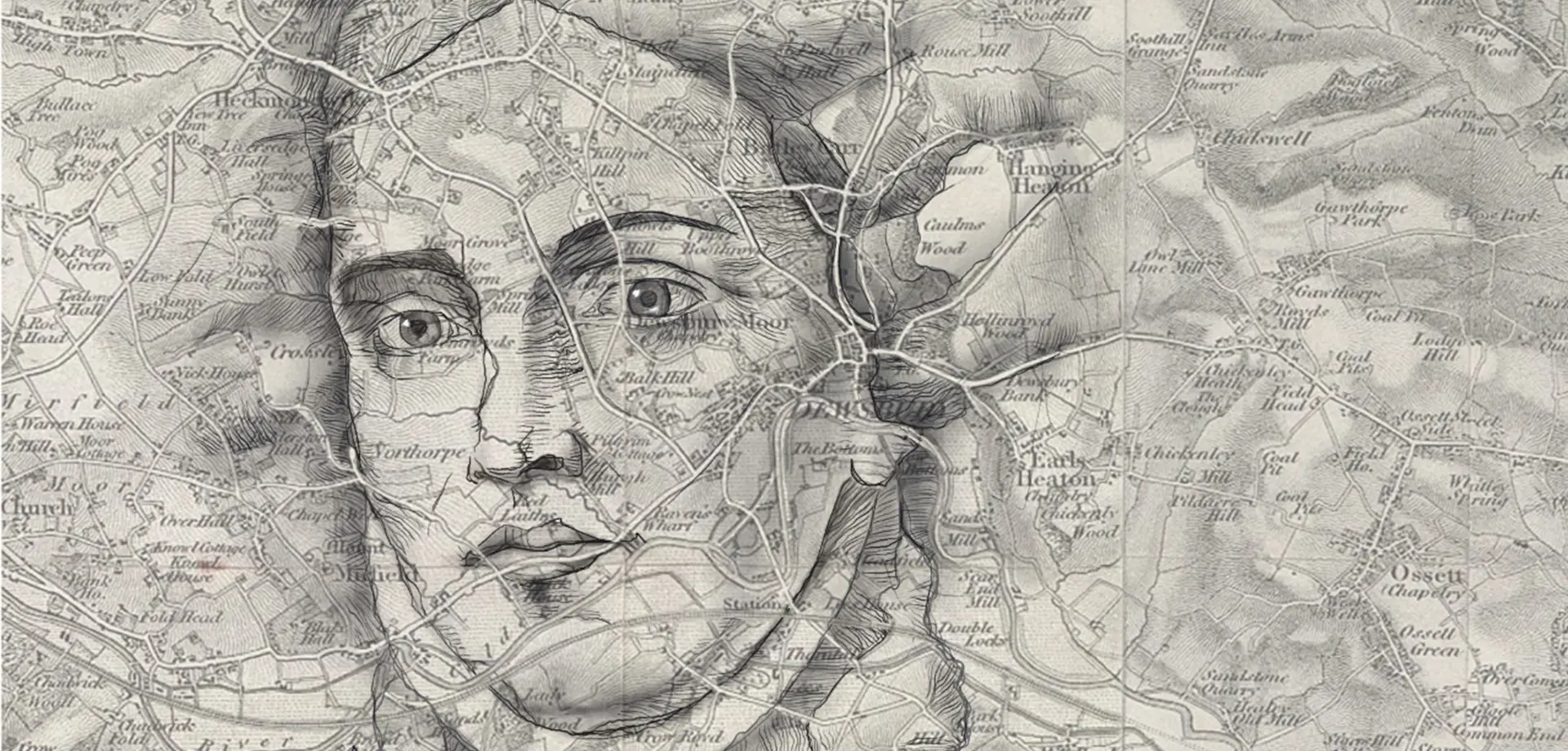We are delighted to publish this guest blog post by Lynn Shouls which draws on Chatsworth’s archives as well as the papers of Anne Lister held by West Yorkshire Archive Service.
A retired lawyer, Lynn Shouls has transcribed about a quarter of a million words from Anne Lister’s diaries and travel journals. Lynn has also written articles on Anne’s coats of arms and her travels in the Peak District.
Anne Lister toured Chatsworth at least twice, and her second visit is recorded in the 1833-1839 visitors’ book. In her journals, Anne makes some notable observations on the house and grounds, and records a chat about the Duke and a meeting with the great horticulturalist and engineer, Joseph Paxton.
Who was Anne Lister?
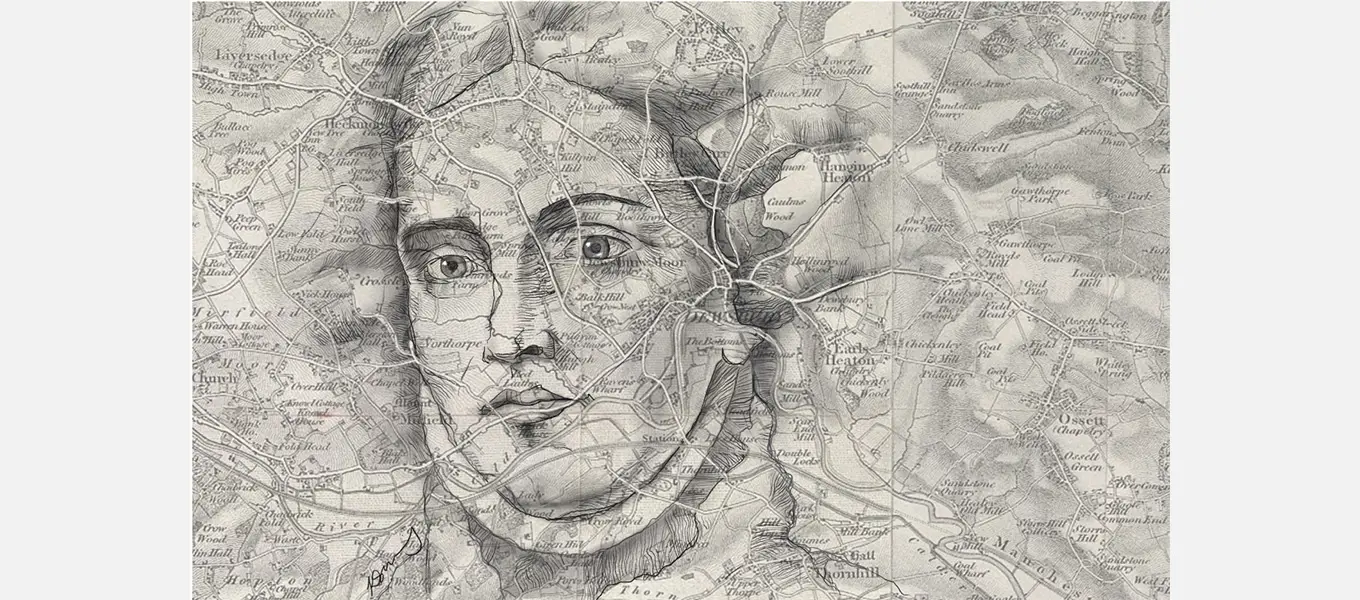
Anne Lister with Yorkshire map.
Image credit: Kylie Conning
The blue plaque affixed to the home of Anne Lister (1791-1840), Shibden Hall, near Halifax, West Yorkshire, describes her as “a diarist, businesswoman, landowner, traveller and lesbian who recorded much of her personal life in a secret code”. Lister is perhaps best known for her extensive diaries, a small portion of which formed the basis for the acclaimed TV series, “Gentleman Jack”.
Anne had an exceptional curiosity about the world around her, and travelled extensively overseas. Yet, like many of us today, she also enjoyed exploring closer to home, including touring the houses and gardens of people who were outwith her social reach. In 1825 and 1835 she toured the house and gardens at Chatsworth.
Anne’s visit in 1825

Extract from Anne Lister’s Diary of 14 September 1825.
Courtesy of West Yorkshire Archive Service, Calderdale, SH:7/ML/E/9/0017
In August 1825 Anne stayed for seven weeks at Buxton’s Great Hotel together with her Aunt, also Anne, to seek improvement of the latter’s poor health by bathing in the spa waters of the town. At the end of August, her long-standing friend and lover, Mariana Lawton, arrived, and stayed for three weeks. During this time, Anne and Mariana took a three-day excursion in the area.
On (or very shortly after) 14 September 1825, Anne wrote:
“ … off to Chatsworth (4 1/2 miles good but hilly) about 12 1/2 – a finish drive there – the ground immediately about Chatsworth fine hill and dale – 35 minutes seeing the grounds, the fountains all playing, and 1 5/60 hour seeing the house – a magnificent place - ”
The fountains were probably the early 18th century fountain in the Canal Pond installed by the 1st Duke of Devonshire (1641-1707) and the Cascade, initially completed in 1696 and then extended between 1703 and 1712.
On this visit, Anne appears to have been most impressed by the brand new kitchen, described by the sixth Duke himself as “handsome and spacious”:
“the kitchen and offices quite as well worth seeing as any part of the building – surrounded with stoves à la Français – at one end a hot table for dishing upon, a hot closet, and steam kitchen, all heated by steam – an immensely wide, deep fireplace for roasting full of burning wood – no coal seems to be used in the cooking department – a pile of wood, in buches, à la Français, near the kitchen door – ”
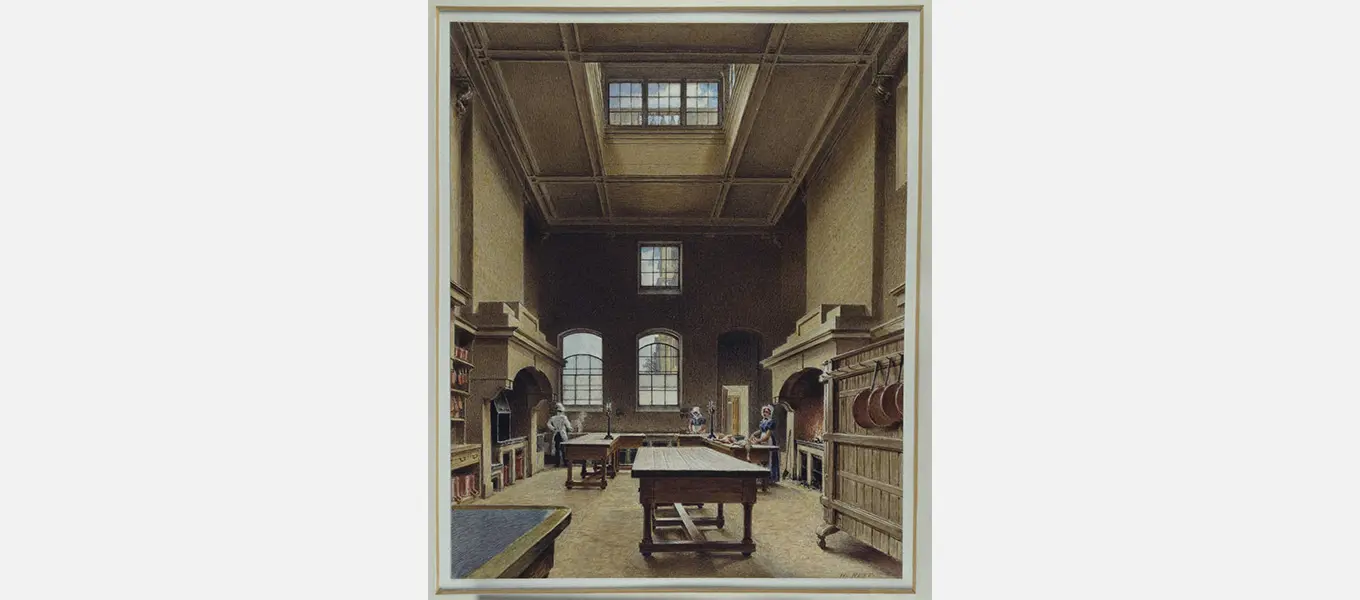
The New Kitchens, Chatsworth by William Henry Hunt c. 1823.
© The Devonshire Collections, Chatsworth. Reproduced by permission of Chatsworth Settlement Trustees.
Anne also painted a vivid picture of the Duke sauntering in the grounds:
“saw the Duke walking leisurely about – very like a gentleman – in a sailor’s short blue jacket and white trousers – but stiff, and set up like a Frenchman of the garde de corps – returned to Bakewell – just stopt to change horses, and off from Bakewell to Ashbourne at 3 3/4”
This, and a sighting of him with friends at her Buxton hotel, seems to be the closest she got to the Duke.
Anne’s visit in 1835

Extract from Anne Lister’s Diary of 18 August 1835
West Yorkshire Archive Service, Calderdale, SH:7/ML/E/18/0083
Anne returned to Chatsworth on 18 August 1835. By this time, the practice of inviting people to sign a visitors’ book had been established. By comparing the 1835 entry with one of Anne’s journals in which she had also written her and her companion’s names, we can infer that Anne herself signed her small party in.

Extract from Chatsworth’s 1833 – 1839 visitors’ book
© The Devonshire Collections, Chatsworth. Reproduced by permission of Chatsworth Settlement Trustees.
The Miss Walker who appears on this page is Ann Walker, whom Anne considered her wife: although Anne knew that they could not legally marry, she believed that she could, in church, solemnise her union with another woman. This Anne and Ann did by taking communion together on Easter Sunday, 1834, and Ann moved into Shibden Hall in August of that year.
In August 1835, the couple were on their way back from a trip to London, stopping at Leamington, Birmingham, and Ashbourne before reaching Buxton and, once more, the Great Hotel.
From there, they travelled to Chatsworth, where Anne gossiped with a Mrs Walters about the Duke’s profligate spending:
“… Had Mrs Walters the mistress of the house a nice well-managing person with a very good countenance … I said it was a pity the Duke of D- [Devonshire] spent so much money - yes! they all regretted it, he was so good; but nobody not even his nearest friends not even Lady Carlisle durst name that to him - farm buildings much wanted at the Inn - they had not even a barn, but they could get nothing done and did not dare say anything - dared not speak to the Duke for the agent would be offended - ”.
Anne told the housekeeper that she would like to meet Joseph Paxton, and her diary reveals some detailed knowledge of him:
“mentioned our wish to see Mr Paxton author and editor of the Botanical magazine who lives at the kitchen gardens about 1/2 mile from the house and not quite so much or about 1/2 as much from the park gate opening into the village of Baslow - Mr P- [Paxton] a native of Bedfordshire - the Duke had him from the Horticultural society 9 years ago, as head gardener - he has now the charge of all the woods also and is the Duke’s factotum, superintends all the alterations in and management of the grounds and is never an hour in one place - has a great deal to do -”.
Mrs Walters was able to say that Mr Paxton was at the house, speaking to the Duke of Bedford, and that she would tell him that Miss Lister and Miss Walker wished to meet him. Anne was fortunate to find Mr Paxton at home - he was much in demand, and sometimes away with the Duke on extensive trips in England and Europe.
Anne and Ann viewed a model of Paxton’s Great Conservatory, construction of which was to begin the following year, and Anne gave her opinion on the projected cost:
“he by and by came in - very civil - gave us a letter to his wife desiring that we might see the gardens the green house etc and the model of the conservatory to be begun immediately be done in about two years, cover 1 acre and 6 perches of the ground, and cost £12,000 I merely observed I thought the estimate should be doubled (i.e. twenty-four thousand pounds) to which he did not seem to object”.
As it turned out, Anne’s projection proved to be more accurate than that of the great engineer – the conservatory ultimately cost over £33,000, and took more than four years to build.
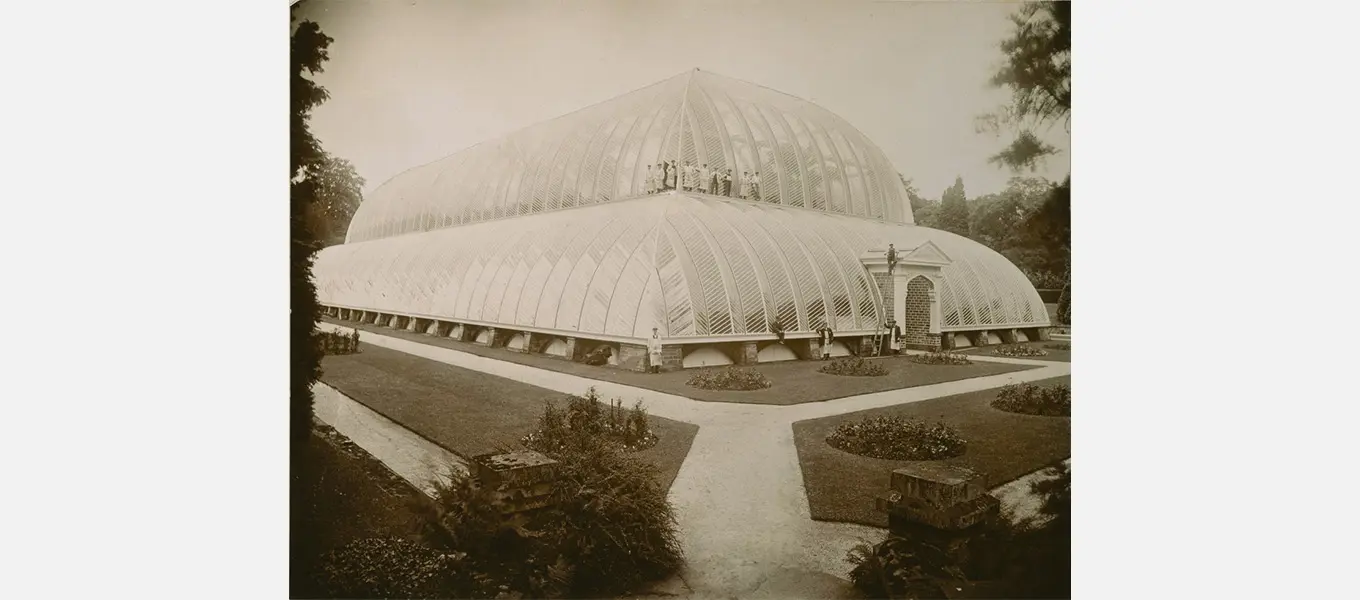
© The Devonshire Collections, Chatsworth. Reproduced by permission of Chatsworth Settlement Trustees.
After their encounter with Paxton, Miss Lister and Miss Walker walked to the house, and managed to avoid touring with a group whom Anne did not like the look of. Never short of an opinion on architectural detail, she set out her views on what was likely the new North Wing:
“ … walked a short way across the park to the house, shewn everyday from 11 to 5 - in the house from 11 25/” to 12 25/” - one or 2 queer looking parties there before us; but we had a very civil housekeeper and avoided them - tho’ the new additions on the north side of the house did not much please us exteriorly (put us in the mind of warehousing and the Italian tower looked odd and out of keeping) yet the interior in point of convenience and magnificence is excellent and excellently adapted to the old part forming altogether a line of west front of 560 ft in length - very fine”.
Anne’s overall impression of the grounds and the house might well be reflected by an 1828 painting by William Cowen.
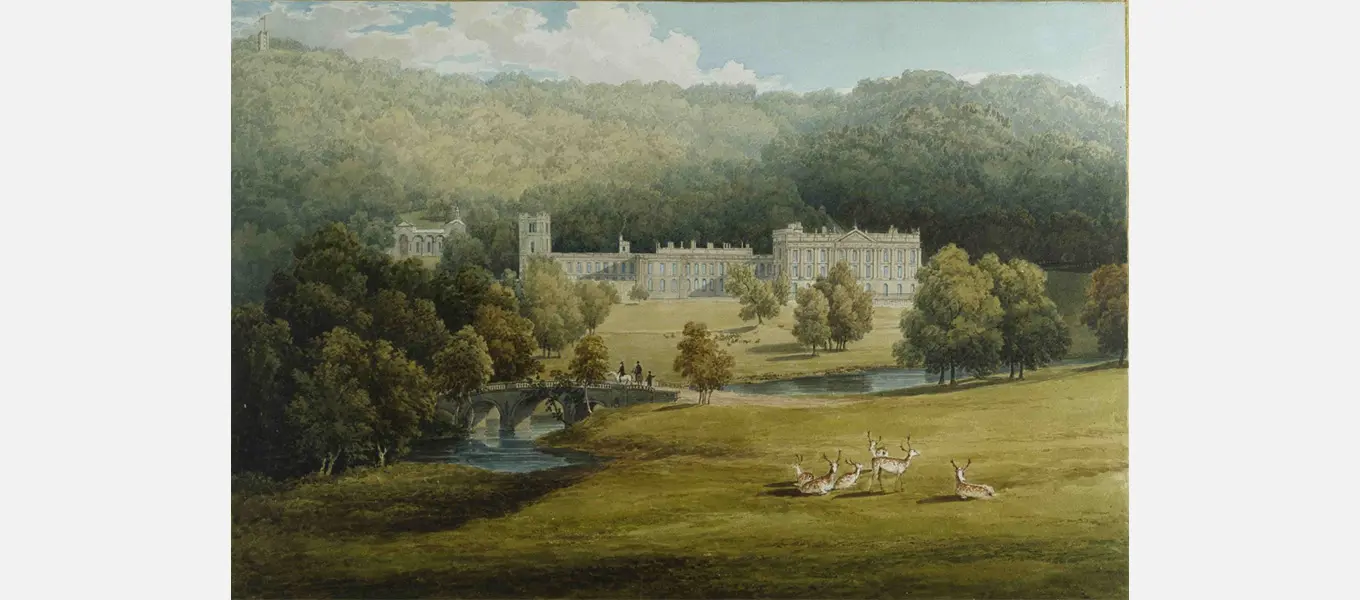
View of Chatsworth from the West, by William Cowen 1828.
© The Devonshire Collections, Chatsworth. Reproduced by permission of Chatsworth Settlement Trustees.
Anne Lister, Chatsworth, and the Great Conservatory
Anne evidently enjoyed her visits to Chatsworth, and made some characteristically acute and unswerving observations about her time there - both of the people she met and of the house and gardens. She was obviously keen to meet Joseph Paxton, being familiar with his work as she was, and having great enthusiasm for horticulture and gardens more generally. Her interest may also have been a practical one - throughout the 1830s, she herself worked on an expensive remodelling of Shibden Hall and its grounds, which included extensive landscaping.
It is no surprise, then, that Paxton's plans for the Great Conservatory particularly caught her attention. Conservatories weren't novel to Anne - in 1830, she visited the Jardin des Plantes (then France's main botanical garden) in Paris several times and on one occasion requested permission to be admitted to the conservatories there as often as she wished. But it is easy to imagine that the sheer scale and vision of Paxton's proposed creation would have intrigued her. Perhaps she was thinking of what she might achieve on her own estate. Whatever the case, it is clear that, far from being in awe of the man, she was quick to give Paxton her thoughts on the likely final cost of the project - testament to her renowned forthright manner, her unusual aptitude for technical detail, and to her own preoccupation with the costs of her plans for Shibden.
A few years later, in 1840, Anne died of a fever while on her travels in Georgia. Sadly, she never got to see - or pass judgement on - Paxton’s Great Conservatory in which she'd taken such a lively interest and which was completed in the same year.
But without her diaries, the occasion of the one meeting between this most singular of women and one of the most extraordinary minds in England during the nineteenth century would have been lost to us altogether. We can only speculate what Anne might have written about a further visit to Chatsworth if she had lived to see it: what is certain is that Anne's diary entries from 1825 and ten years later give us a unique insight into a particularly exciting period of Chatsworth's development and history.
© Lynn E. Shouls


